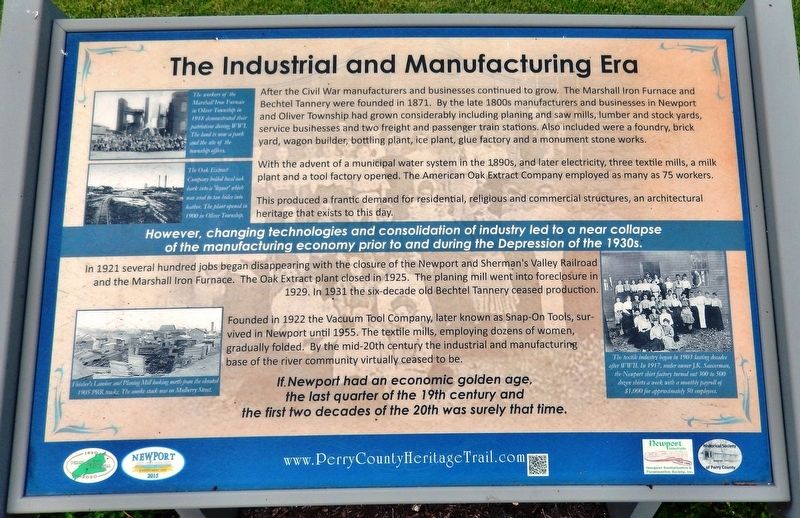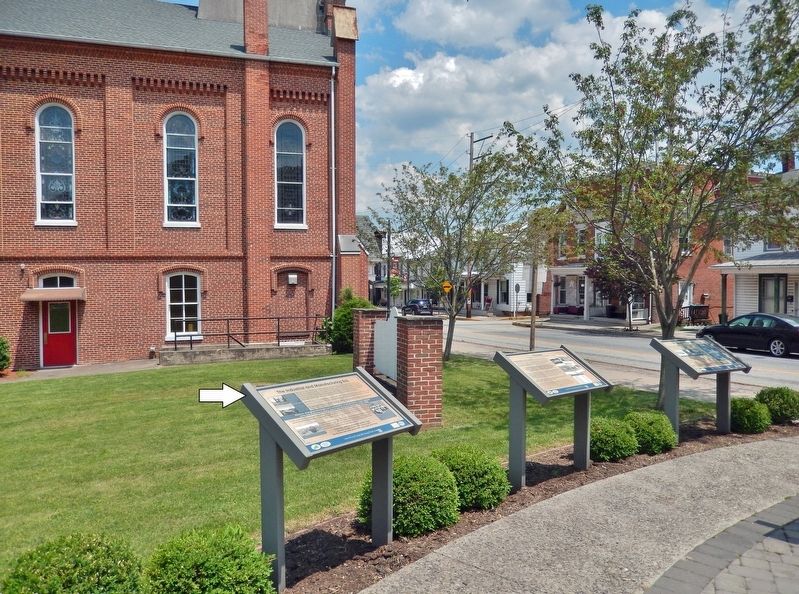Newport in Perry County, Pennsylvania — The American Northeast (Mid-Atlantic)
The Industrial and Manufacturing Era
Perry County Bicentennial
— 1820 - 2020 —
After the Civil War manufacturers and businesses continued to grow. The Marshall Iron Furnace and Bechtel Tannery were founded in 1871. By the late 1800s manufacturers and businesses in Newport and Oliver Township had grown considerably including planing and saw mills, lumber and stock yards, service businesses and two freight and passenger train stations. Also included were a foundry, brick yard, wagon builder, bottling plant, ice plant, glue factory and a monument stone works.
With the advent of a municipal water system in the 1890s, and later electricity, three textile mills, a milk plant and a tool factory opened. The American Oak Extract Company employed as many as 75 workers.
This produced a frantic demand for residential, religious and commercial structures, an architectural heritage that exists to this day.
However, changing technologies and consolidation of industry led to a near collapse of the manufacturing economy prior to and during the Depression of the 1930s.
In 1921 several hundred jobs began disappearing with the closure of the Newport and Sherman's Valley Railroad and the Marshall Iron Furnace. The Oak Extract plant closed in 1925. The planing mill went into foreclosure in 1929. In 1931 the six-decade old Bechtel Tannery ceased production.
Founded in 1922 the Vacuum Tool Company, later known as Snap-On Tools, survived in Newport until 1955. The textile mills, employing dozens of women, gradually folded. By the mid-20th century the industrial and manufacturing base of the river community virtually ceased to be.
If Newport had an economic golden age, the last quarter of the 19th century and the first two decades of the 20th was surely that time.
Erected 2015 by Historical Society of Perry County.
Topics and series. This historical marker is listed in these topic lists: Architecture • Industry & Commerce • Railroads & Streetcars • Women. In addition, it is included in the Perry County Heritage Trail in Pennsylvania. series list. A significant historical year for this entry is 1871.
Location. 40° 28.609′ N, 77° 7.958′ W. Marker is in Newport, Pennsylvania, in Perry County. Marker is at the intersection of Market Street (Pennsylvania Route 34) and 4th Street (Pennsylvania Route 849), on the right when traveling west on Market Street. Marker is located in Newport Heritage Park at the northeast corner of the intersection. Touch for map. Marker is at or near this postal address: 320 Market St, Newport PA 17074, United States of America. Touch for directions.
Other nearby markers. At least 8 other markers are within walking distance of this marker. Floods! (here, next to this marker); Newport Heritage Park (here, next to this marker); St. Paul’s Lutheran Church
(here, next to this marker); Newport's Heritage (here, next to this marker); The Railroad Era (here, next to this marker); The Canal Era (a few steps from this marker); The Settlement of Newport (a few steps from this marker); Newport Historic District (a few steps from this marker). Touch for a list and map of all markers in Newport.
Related markers. Click here for a list of markers that are related to this marker. Newport Heritage Park
Also see . . .
1. History of Newport.
The early economic growth of Newport was determined mainly from its location on the Juniata River. During the early era, freight was transported on rafts on the river. When the Pennsylvania Railroad completed rail service to the town in 1849, the foundation for the tremendous growth in the late 1800s was laid. Grain, lumber, leather and textiles produced in the surrounding communities were shipped via the trains passing through Newport.(Submitted on April 12, 2023, by Cosmos Mariner of Cape Canaveral, Florida.)
2. The Newport Historic District.
The site of Newport began as a local milling and shipping center. Flour and feed moved downstream on flatboats, rafts, and arks to Harrisburg and Baltimore. Industry began to overtake agricultural products in the latter part of the nineteenth century in Newport. Tanneries, utilizing forest and agricultural products, operated in Newport. Later, forges, a brickyard, a planing mill, garment factories, a glass works, a wagon and sleigh manufactory, and a gun smithy all operated in Newport by the turn of the century. Newport furnished products for the surrounding region, including Harrisburg and Baltimore.(Submitted on April 12, 2023, by Cosmos Mariner of Cape Canaveral, Florida.)
Credits. This page was last revised on February 25, 2024. It was originally submitted on April 12, 2023, by Cosmos Mariner of Cape Canaveral, Florida. This page has been viewed 168 times since then and 89 times this year. Photos: 1, 2. submitted on April 12, 2023, by Cosmos Mariner of Cape Canaveral, Florida.

